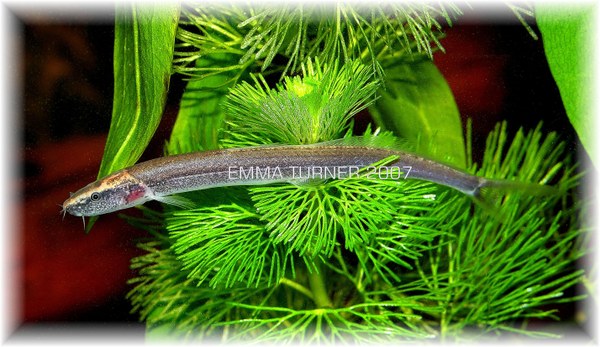Vaillantella cinnamomea
Summary


Scientific name: Vaillantella cinnamomea (Kottelat, 1994)
Common name: Brown Fork-Tail Loach
Synonyms: None
Distribution: Mahakam basin, Kalimantan Timur, Borneo.
Sexual Dimorphism: Mature females likely to show a plumper abdominal area.
Maximum size: Holotype = 4.78cm (1.9") SL.
Similar to: Vaillantella maassi, Vaillantella euepiptera.
Care: A spacious, mature aquarium is required with good filtration and quite a swift current. Filter intakes may need modification in order to protect these slender inquisitive loaches. Ideally, the tank will be darkly furnished with a sand or fine smooth gravel and plenty of bogwood, dense planting and lots of other nooks & crannies amongst rocky caves. If replaced on a regular basis, dried Indian Almond Leaves (Terminalia catappa) may be submerged to create a natural leaf litter, which the loaches will thoroughly enjoy hiding under. Although shy, these fish appear to be highly sociable and should be kept in groups of 5 or more for their continued wellbeing. Tankmates should be small and peaceful.
Feeding: Small frozen foods should be offered on a regular basis. Include baby brinehrimp, cyclops, and daphnia. Small sinking catfish pellets or finely powdered foods can be offered, but there is no guarantee that these fussy eaters will become accustomed to them.
Water parameters: Blackwater. pH: 6.0-6.8. Hardness: Soft. Max dH: 8.
Temperature: 72ºF to 79ºF (22-26°C)
Breeding: This species has not been bred in the home aquarium.
Notes: This species was exported in quantity for the first time during September 2007 along with similarly large quantities of Vaillantella maassi. These two species were apparently caught in the same location at the same time, which shows that their habitats overlap in this area of Kalimantan Timur.
Description: Dr Maurice Kottelat considers that Vaillantella cinnamomea may be distinguished from it's two congeners by the following combination of characters: total anal rays 8-9.5, total dorsal rays 57-59.5, lateral head length 19.5-20.2% SL, pre-dorsal length 16.1-17.2% SL, a light brown colouration with a faint light yellow-brown dorsum and a black stripe from tip of snout through eye to opercle, two faint longitudinal stripes on anterior part of body. The dorsum does not exhibit any contrasting colouration or pattern as do both V. maassi and V. euepiptera.

Photo Gallery
Click to view all images of this species! |
|
Document Actions


